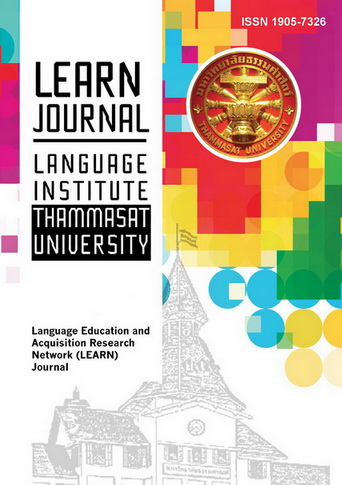A Comparison of the Vocabulary Learning Strategies Employed by High and Low Proficient Pre-University Students in Malaysia
Main Article Content
Abstract
This study was conducted to identify the Vocabulary Learning Strategies (VLS) utilised by 36 Band 5 students as well as 31 Band 3 and below students. This study was vital to look into the similarities and differences in the VLS employed by high and low proficient students as well as to reveal the most useful strategies for vocabulary learning to boost students’ level of proficiency. The VLS-Q (Vocabulary Learning Strategies Questionnaire; Schmitt, 1997) was utilised in this study. The results of this study showed that high proficient students used the ‘English language media’ as the most frequent strategy employed. Nonetheless, low proficient students tend to employ the strategy of ‘asking classmates for meaning’. Strategies from the Memory and Determination categories were the most frequently employed by high and low proficient learners respectively. Implications of the results and suggestions were discussed which are noteworthy in improving vocabulary size and knowledge.
Article Details
References
Aljdee, A. (2011). How teachers implement and make sense of ELT curriculum innovations. AUC TESOL Journal, (Special Issue), 2–10.
Asgari, A., & Mustapha, G. (2012). Vocabulary learning strategies of Malaysian ESL students. Pertanika Journal of Social Science and Humanities, 20(3), 751–763.
Çelik, S., & Toptaş, V. (2010). Vocabulary learning strategy use of Turkish EFL learners. Procedia - Social and Behavioral Sciences, 3, 62–71. https://doi.org/10.1016/j.sbspro.2010.07.013
Che Musa, N., Koo, Y. L., & Azman, H. (2012). Exploring English language learning and teaching In Malaysia. GEMA Online Journal of Language Studies, 12(1), 35–51.
Dóczi, B. (2011). Comparing the vocabulary learning strategies of high school and university students: A pilot study. WoPaLP, 5, 138–158.
Hamzah, M. S. G., Kafipour, R., & Abdullah, S. K. (2009). Vocabulary learning strategies of Iranian undergraduate EFL students and its relation to their vocabulary size. European Journal of Social Sciences, 11(1), 39–50.
Huang, S.-Y. (2010). Effects of major and gender differences on vocabulary strategy use. National Pingtung Institute of Commerce. (Unpublished Master's Thesis). Retrieved from http://140.127.82.166/retrieve/22297/098NPC05741004-001.pdf
Jafari, S., & Kafipour, R. (2013). An investigation of vocabulary learning strategies by Iranian EFL students in different proficiency levels. International Journal of Applied Linguistics & English Literature, 2(6), 23–27. https://doi.org/10.7575/aiac.ijalel.v.2n.6p.23
Khair, S. A. M., Mugaddam, A. R. H., & Eljack, N. S. A. (2018). Investigating the effects of learning strategies on vocabulary achievement among English majors at Sudanese universities Sudan University of Science and Technology Deanship of Scientific Research Journal of Humanities Sciences. Journal of Humanities, 18(2), 2–6.
Ministry of Education (2013). Malaysia Education Blueprint 2013-2015 (Preschool to Post-Secondary Education). Retrieved from http://www.moe.govmy/images/dasar-kpm/articlefile_file_003108.pdf
Mutalib, A. H. binti A., Kadir, R. binti A., Robani, R. binti, & Majid, F. A. (2014). Vocabulary learning strategies among Malaysian TEVT students in German-Malaysian Institute (GMI). Procedia - Social and Behavioral Sciences, 123, 361–368. https://doi.org/10.1016/j.sbspro.2014.01.1434
Nation, P. (1994). Editor's note. In P. Nation (Ed.), New ways in teaching vocabulary. TESOL.
Nayan, S., & Krishnasamy, H. N. (2015). A Preliminary Study on Vocabulary Learning Strategies Used by the Students from the Faculty of Accountancy. International Journal of Languages, Literature and Linguistics, 1(1), 10-14. doi:10.7763/IJLLL.2015.V1.3
Nousin, L.B. (2015). Exploring vocabulary learning strategies used by Bangladeshi undergraduate EFL learners: A comparative analysis of three proficiency level learners. Global Journal of Human-Social Science: Linguistics &Education, 15 (12), 1-11.
Nur Hanisah, S., Sharmila, M. & Seyed Ali, R.K. (2014). Exploring vocabulary learning strategies used by UPM TESL undergraduates. Advances in Language and Literary Studies, 5(5), 1-4. Retrieved from http://dx.doi.org/10.7575/ai
O’Malley, J. M. & Chamot, A.U. (1990). Learning Strategies in Second Language Acquisition. Cambridge University Press.
Oxford, R. L. (1989). Use of language learning strategies: A synthesis of studies with implications for strategy training. System, 17(2), 235–247. https://doi.org/10.1016/0346-251X(89)90036-5
Oxford, R. L. (2003). Language learning styles and strategies: Concepts and relationships. IRAL, 41(4), 271-278.
Rojananak, K., & Vitayapirak, J. (2015). Comparison of English vocabulary learning strategies for good and weak learners at King Mongkut’s Institute of Technology Ladkrabang. International Journal of Languages, Literature and Linguistics, 1(1), 1–5. https://doi.org/10.7763/ijlll.2015.v1.1
Safian, N. H., Malakar, S., & Kalahaji, S. A. R. (2014). Exploring vocabulary learning strategies used by UPM TESL undergraduates. Advances in Language and Literary Studies, 5(5), 1–4. https://doi.org/10.7575/aiac.alls.v.5n.5p.1
Schmitt, N. (1997). Vocabulary Learning Strategies. In: Schmitt, N. and McCarthy, M. (Eds.), Vocabulary: Description, Acquisition, and Pedagogy (pp. 198-227). Cambridge University Press.
Sohrabi, B., & Iraj, H. (2016). Implementing flipped classroom using digital media: A comparison of two demographically different groups perceptions. Computers in Human Behavior, 60, 514–524. https://doi.org/10.1016/j.chb.2016.02.056
Subon, F. (2013). Vocabulary learning strategies employed by form 6 students. International Journal of Scientific and Research Publications, 3(6), 1–32. Retrieved from http://www.ijsrp.org/research-paper-0613/ijsrp-p18133.pdf
Wei, M. (2007). An examination of vocabulary learning of college-level learners of English in China. Asian EFL Journal, 9(2), 93–114. Retrieved from http://asianefljournal.com/June_2007_EBook_editions.pdf#page=93
Zarrin, S., & Khan, Z. (2014). A study of vocabulary learning strategies among undergraduate learners of A.M.U. US-China Foreign Language, 12(1), 75–82.


